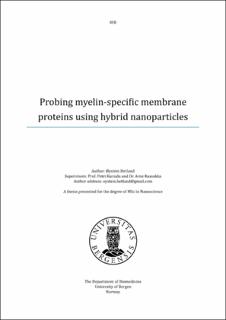| dc.description.abstract | Neuroscience is the study of the nervous system and its diseases. Neurological diseases are common and among the least understood class of disease in humans. Demyelinating diseases,, such as multiple sclerosis and Charcot-Marie-Tooth disease, impair the transmission of nerve signals throughout the body. This is caused by damage to the insulating membrane formed around neurons called myelin. The myelin membrane is held together by protein-membrane and protein-protein interactions, with these being a principal target of investigation. Contemporary methods for analyzing protein-membrane interactions are commonly restricted by inherent instabilities and weaknesses of the model system. Accordingly, the root cause of demyelination remains elusive, restricting our ability to provide a cure or effective treatment. Nanoscience is an emerging field of science, rapidly revolutionizing the natural sciences. In this thesis, nanoscience was applied to neuroscience, facilitating quantification of protein-membrane interactions. Through a process of rapid iteration, a novel model nano-bio hybrid system was developed, tested, and applied for analysis. The model system exploited nanoscale size, shape, and surface of amorphous silica nanoparticles to stabilize a lipid bilayer. The resulting hybrid of inorganic and organic material represents a label-free method for quantitative analysis of protein-membrane interactions. The hybrid was rigorously tested, using diverse ensemble of methods to gauge the viability of the model system. The mature system was used to investigate the myelin-associated proteins myelin basic protein (MBP), peripheral myelin protein 2 (P2) and cytoplasmic tail of myelin protein 0 (P0ct). Coupled with conventional methods, such as isothermal calorimetric titration, the hybrid eliciting previously unreported properties of myelin-associated proteins. The thermodynamics of membrane binding and insertion of MBP, P0ct and P2 were quantified, with a fidelity surpassing that of any other model system currently in use. | |
